Learning to walk with a prosthetic limb is not just about movement — it’s about rebuilding trust with your body. It’s a process filled with learning, adjusting, and unlearning. Many people assume that once a prosthetic fits and you can stand, walking will follow naturally. But gait is more than just putting one foot in front of the other. It’s about balance, posture, timing, and coordination. It’s a skill that needs to be trained — and like any skill, it’s easy to pick up bad habits along the way.
At Robobionics, we’ve worked with thousands of amputees at different stages in their recovery and training journey. Over time, we’ve seen patterns — small errors that start early and grow bigger if left uncorrected. These mistakes are common, but the good news is they’re also preventable. With the right approach, you can avoid setbacks, reduce discomfort, and build a smooth, confident gait.
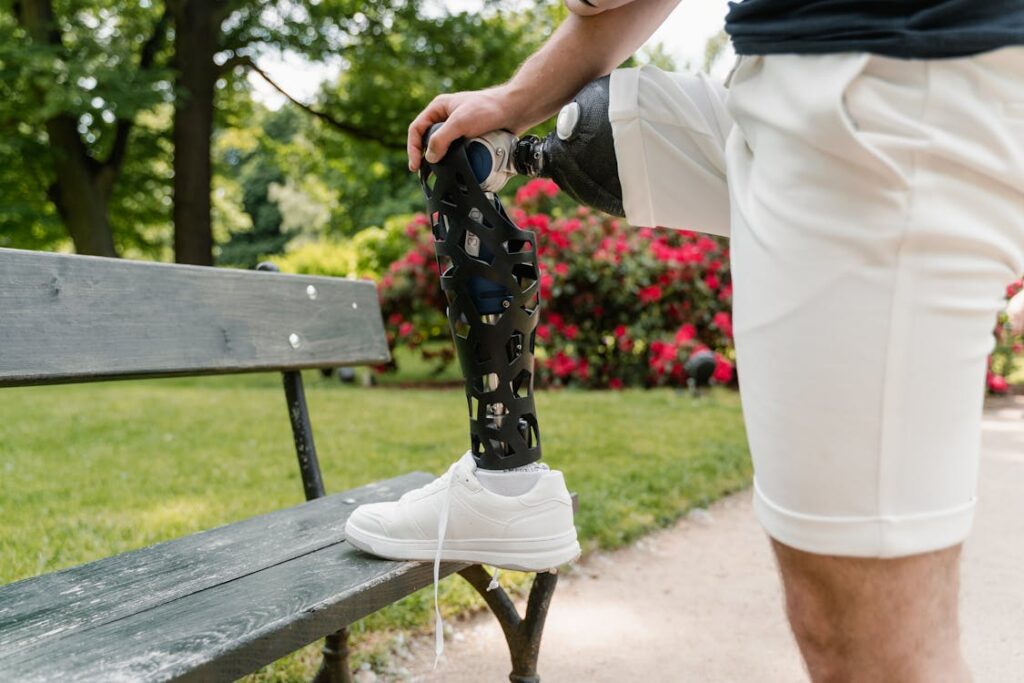
Understanding the Foundation: Why Gait Training Needs More Than Just Practice
Learning to Walk Again Isn’t Just Physical
Many people don’t realize how deeply connected walking is to the brain. Before your legs even move, your brain is working — planning your step, sensing your balance, and reacting to every small change in the ground beneath you. After an amputation, that entire system has to adapt. And while prosthetics can replace lost limbs, they don’t replace sensation. That’s where training comes in.
When you first start walking with a prosthetic, your brain might feel unsure. It may send signals to protect the body. This can lead to overcompensating with your other leg, keeping your weight off the prosthetic side, or stiffening your posture. These may feel natural at first, but they actually create more effort and less balance. If these habits stick, they can lead to long-term discomfort or injury.
Good gait training teaches your brain and body to move with confidence again. But that process doesn’t happen overnight — and it doesn’t work if you’re repeating movements without awareness. That’s why simply “practicing more” isn’t always enough. If you practice the wrong pattern, you only make it stronger. Learning the right way, from the start, matters.
Mistake 1: Relying Too Much on the Non-Amputated Side
One of the first things we often see in new prosthetic users is uneven weight distribution. It’s completely understandable. When one side of your body feels different, it’s natural to shift more weight to the side that feels familiar. But this creates an imbalance. Over time, it causes strain on your stronger leg, hip, and back.
When one side does most of the work, your body has to twist and adjust with every step. This throws off your alignment. Even if your prosthetic leg is perfectly built, it won’t function properly if your body doesn’t trust it.
The solution isn’t just physical — it’s mental too. You need to slowly teach your body that it’s safe to use the prosthetic side. Start with supported standing exercises that focus on even weight bearing. Practice feeling the ground through both sides. The more you include the prosthetic in small, simple tasks, the more natural it becomes to share the load.
This takes time. But every time you make your prosthetic side work, even just a little more, you’re building a more symmetrical, stable gait.
Mistake 2: Looking Down While Walking
It’s very common for new users to watch their feet while walking. It feels like it gives you more control. But in reality, looking down can hurt your form. It pulls your head forward, rounds your shoulders, and shifts your center of gravity. This not only throws off your balance but also weakens your posture over time.
When your head drops, your whole body follows. The weight shifts forward, your back muscles stay tight, and your core stays disengaged. It might feel safer, but it makes walking harder.
What you really need is head-up walking. This allows your spine to stay straight, your chest to stay open, and your eyes to take in the world around you. It feels strange at first — especially when you don’t fully trust your steps — but it’s a crucial part of natural gait.
To make the transition easier, start in safe, familiar spaces. Walk next to a wall or railing. Keep your eyes focused ahead. Trust that your feet — and your prosthesis — will do their job. The more you look up, the more your brain learns to rely on feeling and rhythm instead of constant visual control.
Mistake 3: Taking Short, Uneven Steps
After amputation, many people develop a short, hesitant step on the prosthetic side. This is another protective habit. It keeps your body from fully committing to the stride. But it also creates a limp-like pattern that’s harder to unlearn later.
Short steps reduce the power of your stride. They also affect how your foot hits the ground, how your hips move, and how your upper body responds. Over time, they create tightness in your muscles and leave you feeling tired after even short walks.
The fix? Practice full, even steps. This doesn’t mean taking giant strides. It means matching both sides — allowing your prosthetic foot to move forward just as far as your natural one. You might need help from a mirror, a video, or a gait trainer at first. And you’ll definitely need patience.
As your confidence grows, so will your stride. And as your stride evens out, you’ll feel smoother, more balanced, and less exhausted at the end of each day.
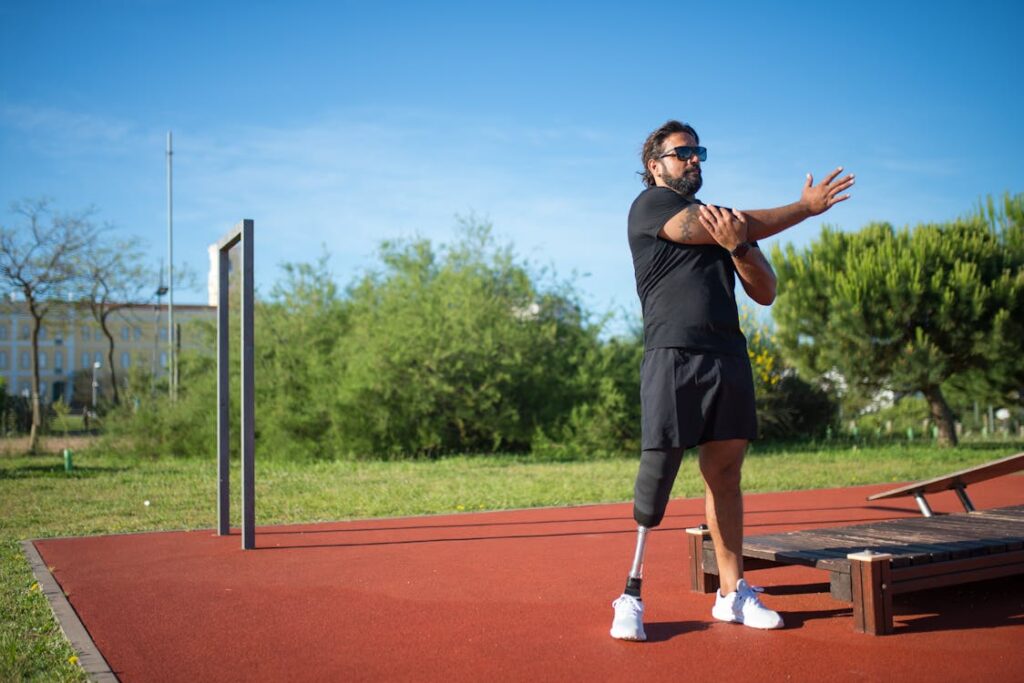
Correcting Technique: Where Good Habits Begin and Bad Habits End
Mistake 4: Locking the Knee or Stiffening the Leg
A very common issue we see during gait training is walking with a stiff prosthetic leg. Often, users lock the knee joint or keep their entire leg too straight through the swing and stance phases. This usually happens out of fear — a natural desire to feel more stable. But ironically, stiffening the leg actually makes walking more difficult and less stable.
When the leg stays straight, it can’t absorb shock properly. It also creates a jarring movement when the prosthetic hits the ground. This throws off your rhythm and can make every step feel heavy and effortful. In some cases, it even causes dragging or tripping.
Instead of trying to “freeze” the leg for safety, focus on controlled movement. You want your prosthetic leg to mirror your natural leg as closely as possible. That means a slight bend in the knee during the swing, followed by a soft landing where the weight is gently transferred. Practicing in a slow, controlled environment — like a hallway with support bars — can help your body learn to trust the motion without fear.
Softening your gait also protects your joints and allows the prosthetic to work the way it was designed to — absorbing impact, returning energy, and supporting smooth transitions.
Mistake 5: Overstriding and Forcing the Step
While some people take steps that are too short, others go the opposite way. They overstride — reaching too far forward with the prosthetic limb in an attempt to take “normal-looking” steps. But longer doesn’t always mean better. Overstriding creates a braking effect, where your foot lands too far ahead of your body. This increases impact, slows you down, and puts more pressure on your joints.
For prosthetic users, this can also cause the socket to shift or rotate uncomfortably. It may feel like the limb is “pulling” or lagging behind. Over time, this reduces efficiency and makes walking much harder than it needs to be.
Instead of chasing a long stride, focus on a rhythmic one. Your goal is to create a smooth, repeatable step where the prosthetic leg lands just slightly ahead of the body and the weight flows forward. Use your core and hips to drive the motion rather than your foot.
A healthy stride is about timing and control — not length. When you get the rhythm right, your body will cover more ground naturally, without effort or strain.
Mistake 6: Ignoring the Upper Body
It’s easy to think of gait training as just a leg exercise. But your upper body plays a critical role in how you walk. Your arms help balance each step, your shoulders affect posture, and your core keeps everything aligned.
One common error is letting the arms stay stiff or swing unevenly. For example, some users stop using the arm on the prosthetic side entirely. This creates a visible imbalance and can throw off the rhythm of the walk.
To avoid this, practice active arm swings while walking — nothing exaggerated, just enough to mirror your natural side. Keep your elbows slightly bent, and let your arms move naturally in opposition to your legs.
Your shoulders should stay level, not hunched or dipped. Keeping your chest open and your neck relaxed helps with breathing, energy, and balance.
We also encourage core engagement during walking drills. A strong core stabilizes your spine and helps your hips move smoothly. It prevents side-to-side swaying, which often happens when one leg is doing more work than the other.
In short, your gait is a full-body activity. The more attention you give to posture, arm movement, and core control, the more efficient and comfortable your walk will become.
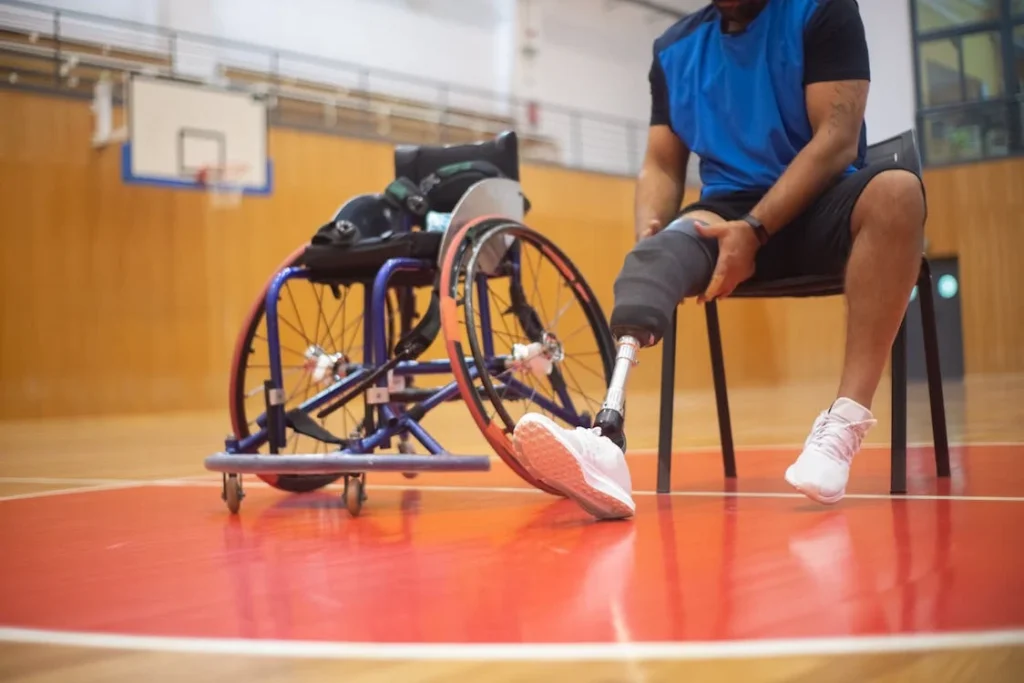
Training Environments and Emotional Triggers That Influence Gait
Mistake 7: Practicing Only in Controlled or Clinical Settings
Most prosthetic gait training begins in a controlled space — parallel bars, smooth floors, bright lights, and constant support. This is a necessary first step. It’s where confidence is built, patterns are introduced, and safety is ensured. But staying in this comfort zone too long can limit progress.
When walking only in ideal conditions, the body and brain get used to flat, obstacle-free paths. But the real world is different. Streets have slopes. Parks have gravel. Homes have corners, carpets, and unexpected turns. If your training never includes these variables, your gait may fall apart outside the clinic.
That’s why one of the most valuable phases in gait training happens outside. Practicing on different surfaces — grass, tiles, pavement — teaches your body how to adjust. Walking in crowded areas trains your focus and foot placement. Stairs build strength and coordination. These real-life experiences sharpen your control and build long-term independence.
It’s important to progress at your own pace. But as soon as you can, begin exploring outside your training space. This exposure boosts not only your movement skills but also your confidence in navigating life on your own terms.
Mistake 8: Letting Fear and Frustration Control the Process
Every person learning to walk again will face moments of doubt. The fear of falling, the discomfort of imbalance, and the frustration of slow progress can all weigh heavily. These feelings are normal — but when they take over, they can interrupt the training process.
Fear causes hesitation. Hesitation leads to stiffness, shallow steps, or delayed reactions. The body tightens. Movements become jerky or cautious. Frustration does something similar. It shortens your patience, encourages poor posture, and sometimes leads to giving up too soon on new exercises or techniques.
We often tell our clients: progress isn’t linear. Some days will feel smooth. Others will feel like you’ve taken a step back. That’s not failure — it’s part of how the body and brain adapt. One of the best things you can do is be kind to yourself. Acknowledge the challenge. Celebrate the small wins. Accept the rough patches without judgment.
Training should be consistent, but also forgiving. If a session goes poorly, reset the next day. If a new technique feels awkward, keep practicing without forcing it. And if fear is holding you back, talk about it — with your trainer, your prosthetist, or someone who understands your journey.
When you train with calm, focus, and self-compassion, your body responds better. Movement becomes more natural. And the process becomes something you own, rather than something you just push through.
Mistake 9: Not Listening to Discomfort or Early Warning Signs
Pain is the body’s alarm system. But in gait training, people often ignore it. They assume soreness is part of the process or that pushing through pain shows strength. While some discomfort is expected during learning, sharp or persistent pain is never normal.
A poorly aligned socket, a worn-out foot module, or a slight rotation in the hip can all lead to pressure points, swelling, or muscle strain. These don’t start suddenly. They build up slowly. If you notice discomfort at the same spot every day, that’s your body asking for help.
Ignoring these signals can lead to serious issues — skin breakdown, joint problems, even falls. On the other hand, responding early often requires only a small change. Adjusting the alignment. Re-padding the socket. Modifying the training load.
Regular check-ins with your prosthetist or trainer make a huge difference. They can spot what you might miss. And when your equipment and body are in sync, gait training becomes smoother, safer, and more successful.
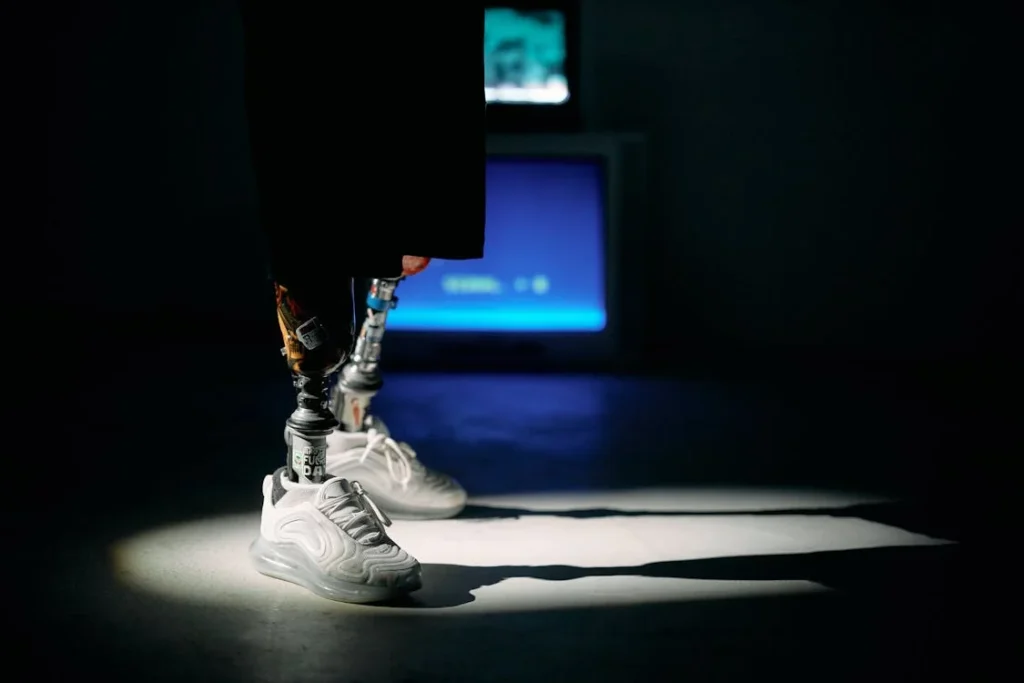
The Role of Equipment and Communication in Gait Training Success
Mistake 10: Using a Prosthesis That Isn’t Properly Tuned for Gait Training
Even the most advanced prosthetic limb cannot function correctly if it doesn’t match your body, your gait phase, or your lifestyle. Many users begin their gait training journey with a prosthesis that’s been fitted for standing or casual walking — not for active motion. This misalignment creates subtle challenges that slow progress and increase effort.
If your prosthesis is too tall, it can cause your hip to hike with every step. If it’s too short, you may lean or collapse on one side. A stiff foot can stop proper rollover. An overly soft knee unit can buckle under pressure. These issues may not be obvious at first — especially to a new user — but they show up in the rhythm of your gait, the fatigue you feel, and your ability to progress.
This is why fine-tuning is not a luxury; it’s a necessity.
At Robobionics, we treat each adjustment as a conversation between the body and the device. A few degrees of rotation or a few millimeters in height can mean the difference between a smooth step and one that pulls the whole body out of sync. During gait training, regular tuning ensures your equipment evolves with you — not against you.
A properly tuned prosthesis supports natural motion. It reduces compensations. It builds trust. And it gives your body permission to walk the way it was meant to — strong, balanced, and free.
Mistake 11: Skipping Follow-ups and Underestimating the Importance of Teamwork
One of the most silent but damaging mistakes people make in gait training is trying to go it alone. They assume once they’ve received their prosthesis and finished the initial sessions, they can “figure it out” on their own. But gait training is not a one-person job. It’s a partnership — between the user, the prosthetist, the therapist, and sometimes even a coach or support group.
Each member of the team sees something different. A prosthetist notices mechanical alignment. A therapist sees movement patterns. The user feels comfort and energy return. When everyone communicates clearly, small issues are solved before they grow. Progress stays steady. Setbacks are avoided.
Follow-ups are essential, especially during the first 6 to 12 months. This is when your body is still adapting. Muscles are rebuilding. Skin is toughening. And your brain is rewiring its patterns. Even after that first year, check-ins every few months help track alignment, comfort, and performance.
More importantly, regular contact builds confidence. It reminds you that you’re not doing this alone. It gives you space to ask questions, express concerns, and celebrate progress — not just when things go wrong, but when they go right.
Mistake 12: Treating Gait Training as Temporary
This is perhaps the most widespread misconception — that gait training is something you do for a while, and then stop once you’re “walking fine.” But gait, like any complex skill, evolves. Bodies change. Lifestyles shift. Equipment wears over time. And what worked for you at six months post-fitting may not support you at two years.
If you stop training completely, small habits can return. Muscles can weaken. Balance can fade. And your stride may start to feel heavy or uneven again.
The better approach is to make gait care part of your lifestyle. You don’t need daily drills forever. But checking in with your form, doing occasional balance work, maintaining strength, and staying alert to discomfort — these are long-term habits that support lifelong comfort and confidence.
We encourage users to treat their gait like a runner treats form or a musician treats technique — not as something to finish, but as something to keep refining. The reward is freedom of movement, reduced fatigue, and a body that feels like it’s working with you, not against you.
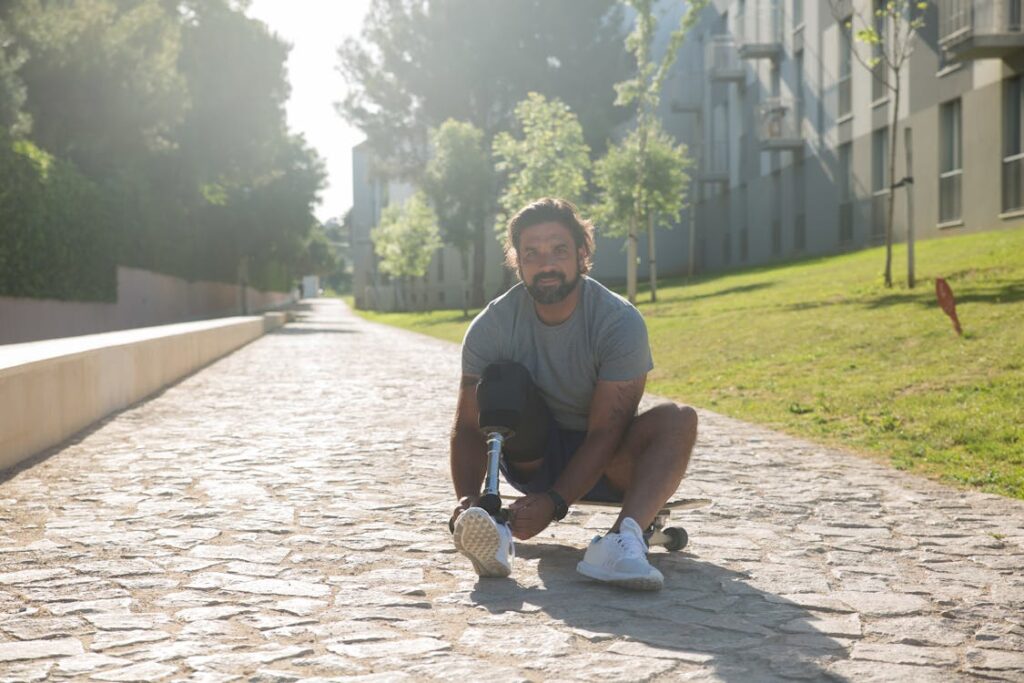
Cultural Beliefs, Body Image, and the Silent Influence on Gait Confidence
What We Carry Into Gait Training Beyond the Physical
Gait training is often viewed as a purely clinical or mechanical process — legs, limbs, angles, and alignment. But behind every person learning to walk with a prosthetic is a deeper story. It’s not just about the body. It’s about how that body is perceived, both by the individual and by the people around them.
In many parts of the world, including India, social beliefs around disability can deeply affect how amputees view themselves. These beliefs — sometimes subtle, sometimes openly expressed — influence confidence, willingness to engage in public life, and even posture during walking.
When someone grows up in an environment where physical difference is seen as weakness or something to hide, that message doesn’t disappear during gait training. It walks with them. It shows up in small hesitations, in the way they carry their shoulders, in the lack of eye contact during walking sessions. These cues aren’t mechanical. They’re emotional. And they matter.
We’ve seen users who have technically “good” gait patterns still move with uncertainty — not because their prosthetic doesn’t work, but because they haven’t fully accepted their new body in a social context.
Body Image Shapes Movement
If someone feels self-conscious about their prosthetic, it shows up in how they walk. They may avoid crowded places. They may try to rush their steps to avoid being watched. They may limit their stride so their movement doesn’t draw attention. They may overcompensate — walking with extra stiffness or confidence to cover up their discomfort.
None of these behaviors are flaws. They are coping strategies. But they also block progress in gait training.
To truly walk freely, one must feel safe in their body — not just physically, but socially. That safety allows for openness in posture, naturalness in rhythm, and joy in motion.
This is why part of our work at Robobionics includes conversations around self-image. We help users understand that their prosthetic is not a mark of limitation, but a symbol of resilience. That walking with a prosthetic is not something to be hidden — it is a powerful, visible expression of overcoming.
Clothing, Appearance, and the Psychology of Comfort
It may seem unrelated, but the clothes someone wears during gait training matter. Tight clothes that make the socket area obvious, or shoes that don’t match prosthetic height, can increase self-consciousness. Ill-fitting outfits can cause chafing, poor foot alignment, or posture issues.
But beyond physical fit, appearance affects mindset. If a user doesn’t feel like themselves when wearing a prosthesis — if they feel “medical” instead of “whole” — that discomfort can disrupt focus and confidence.
This is why we encourage users to dress in a way that reflects their identity during training. Whether that means athletic wear, traditional clothing, or something personal, the key is to feel good in your own skin. Feeling dignified and confident leads to more upright walking, more engagement in the session, and a stronger mind-body connection.
Creating Social Space Around the Prosthetic User
No gait training happens in isolation. Family, friends, trainers, and even strangers on the street play a role. Sometimes, their well-meaning concern becomes overprotection — not letting the person walk on their own, constantly watching their steps, or commenting on their speed or form.
Other times, it’s silent judgment — a stare in public, a child’s question, an awkward conversation. These can shape how the prosthetic user sees themselves.
A truly empowering gait training experience includes preparing for these social moments. We encourage open family involvement — teaching loved ones how to support without hovering. We help users build responses to public curiosity that are firm but friendly. We create role-play scenarios where confidence can grow in a safe setting.
Because when you feel supported socially, you walk with more power physically.

The Role of Sensory Substitution and Proprioception in Relearning Natural Movement
What Happens When the Body Loses Sensation
When a person loses a limb, they don’t just lose muscle and bone — they also lose a crucial sensory connection. In the natural body, we rely on thousands of tiny signals from the skin, muscles, joints, and nerves to know where our limbs are, how they’re moving, and how much pressure they’re applying. This sense is called proprioception — your body’s ability to “feel” itself in space.
After amputation, this feedback loop is disrupted. With a prosthetic, you no longer have direct nerve input from the foot or ankle to tell you how hard you’re stepping, how flat the ground is, or when your toe is about to catch a surface. Most people don’t think about these things until they’re gone — but for prosthetic users, the absence of this information can make gait training much harder than expected.
What often looks like a “mechanical” gait issue — a hard step, a missed foot placement, an uneven stride — is sometimes the result of missing sensory input, not poor technique.
How the Brain Adapts to New Sources of Feedback
Fortunately, the brain is adaptable. It can learn to use new information from different parts of the body to replace the sensory input it lost. This process is called sensory substitution.
In gait training, we help the brain learn to pick up new cues — like the sound of the prosthetic foot hitting the ground, the feel of vibrations through the socket, or visual input from how the body moves in a mirror. Over time, these new signals help rebuild that lost sense of awareness.
Some users even begin to feel their prosthetic in a meaningful way, not because of nerves, but because their brain has rewired itself to interpret indirect feedback as real. They learn how pressure changes in the residual limb signal a full step. How shoulder position can tell them if their posture is correct. How rhythm, when practiced enough, becomes second nature.
This is an incredible process — one that requires time, repetition, and gentle coaching. But when it happens, users begin to move with confidence, not because they’re “forcing” control, but because they’ve rebuilt an internal compass.
Training With Attention, Not Just Movement
This is why high-quality gait training isn’t just about drills. It’s about awareness. When we ask a user to walk down a hallway, we don’t just watch their feet — we ask them what they felt. Was the socket pressing more on one side? Did the stride feel longer or shorter than before? Did they notice where their weight shifted?
At first, many don’t know how to answer. They’re used to focusing on “right or wrong,” not “how it feels.” But as we repeat the question, their body begins to respond. They start to notice pressure, timing, tension, and flow. And that awareness leads to better form, better comfort, and better control.
It’s not just training the muscles — it’s training the brain to reconnect with the body, even when that body includes a mechanical limb.
Future Possibilities in Sensory Feedback Technology
At Robobionics, we’re also exploring next-generation solutions to bring real-time feedback into prosthetic limbs. From smart sockets that detect pressure changes to foot modules that deliver haptic responses, the future of gait training may include direct prosthesis-to-brain communication.
But even before those tools are widely available, we can teach users how to harness their remaining senses in powerful ways. The body is always listening — even when it has to learn a new language.
Conclusion
Prosthetic gait training is not just about learning to walk — it’s about learning to move well, with balance, awareness, and confidence. The journey is complex, filled with both physical and emotional layers. Mistakes are part of the process, but with the right guidance, they don’t have to become habits.
At Robobionics, we believe every step is a conversation between body, mind, and technology. From posture and alignment to confidence and culture, gait training touches every part of a person’s identity. True progress comes when training goes beyond drills and devices — when it begins to rebuild connection, trust, and independence.
Whether you’re just starting or refining your stride, know this: the goal isn’t perfection. It’s movement that feels right, reflects your strength, and supports the life you want to live.
Walk tall, walk proud — and never walk alone.



